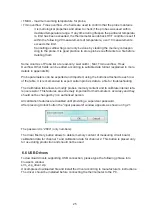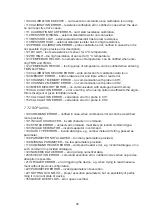
28
7.2.9 Commands’ execution
There are two possible methods of executing commands in the standard: holding and non-
holding. In case of the first one, a command is executed until the previous one finishes.
In case of non-holding option, commands are performed in parallel. Thermometer runs
commands in holding mode, which means in some cases it is required to wait over a dozen
of seconds before achieving a response from device.
7.2.10 Default commands
To shorten the contents of messages to send, in some cases there were so called “default
commands” defined. These ones are put into square brackets, and their contents can be
omitted while calling the command, not causing changes in executed function. Only one
command can be default in specific catalogue. As an example, in :MEAS catalogue, TEMP
and VAL are default commands:
:MEASure
[:TEMPerature]
[:VALue]
:GRADient
:RESistance
It means that temperature value can be read in three ways:
1) :MEAS:TEMP:VAL?
2) :MEAS:TEMP?
3) :MEAS?
The thermometer doesn’t enter command catalogues by default, therefore to enter any ca-
talogue, its name must appear in message. Per example then, to read temperature’s value,
gradient and resistance, it can be commonly achieved by sending:
:MEAS:TEMP:VAL?; GRAD?; RES?
To shorten the message however, default commands can be used:
:MEAS:TEMP?; GRAD?; RES?
:MEAS?; TEMP:GRAD?; RES?
But following message will result as an error:
:MEAS?; GRAD?; RES?
since it doesn’t include entrance to TEMPerature catalogue. Temperature value will be read
properly, and then the error will occur.
7.3 Status registers
IEEE-488.2 and SCPI standards implement quite expanded status system. Contents of
each of registers is described below. Event’s occurrence is indicated by setting specific bit
to 1.
7.3.1 STB status register
It is the most important status register, containing eight bits, which store information about
device’s state. While using GPIB main line, setting RQS bit equals to interrupt notification.
Reading the value of this register causes it to reset. The meaning of its bits:
• 0 and 1 bit – defined dependently on the type of device. In thermometer, both are 0,
• 2 bit ERROR – indicates the occurrence of errors in error queue; its value is 1 when there
are errors, 0 if the queue is empty;
Содержание LDT 2000
Страница 1: ...1 LDT 2000 PRECISION THERMOMETER MANUAL...
Страница 14: ...14 5 Typical performance of the thermometer...
Страница 15: ...15...
Страница 16: ...16...
Страница 17: ...17...
Страница 43: ......
Страница 44: ......
















































